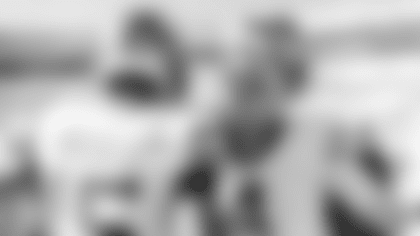Von Oelhoffen shows hustle during the drill
The 2006 bye week for the New York Jets' defense meant a lot more than rest and relaxation. Other than the fact that the annual bye fell in week nine – splitting the season perfectly in eight game halves – the weekend off proved to be significant in their eventual success.
In the first half of the season, the Jets defense surrendered 359.1 yards per game while the opposition averaged more than 24 points an outing. During this opening stretch, the defensive front seven adapted to not just the 3-4 defense, but to a multi-faceted attack that interchanged religiously. But inconsistency and inability to stop the run made it look as though the unit was going to need at least a full year to get comfortable in the new system.
However, when that bye week came and went, the Jets – led by the defensive line – refueled for a mesmerizing second half of the year performance. The entire team responded to the success from the big men up front and it led to a 6-2 run into the postseason.
"It's a real tribute to our players and coaches that our defense consistently improved as the season went on. That is representative of being well-coached and players taking to the coaching," said New York GM Mike Tannenbaum. "The run defense improved considerably over the second half of the season and that kept us in a lot of games."
The scoring production of Jets' opponents was slashed in half as the defense gave up just over 12 points per game following the week off. The Green and White's sack total increased from 13 in weeks one through eight to 22 in weeks 10-17. The run defense was stellar, giving up just one rushing touchdown in the final eight weeks compared to 13 prior to the mid-season break.
"The short yardage and goal line defense was actually very good, especially stopping the run," said Tannenbaum. "There were some things to be encouraged by, and there were definitely areas where we will need to improve."
One area in which Tannenbaum may not have to focus improvements is the defensive end position. Bryan Thomas, who lined up along both the line as well as outside linebacker, was arguably the face of the front seven this year as he had his most productive professional season. The UAB alum nearly doubled every career-high from his previous four years with the Green and White. Thomas caught fire in the second half of the season and collected 6.5 of his 8.5 sacks in those final eight games. For his dominant play and favorable flexibility, Thomas was rewarded with a contract extension.
Another important piece of the front line puzzle that was somewhat overshadowed all season long was the presence of Kimo von Oelhoffen. The 6'4", 299-pound versatile lineman came to the Jets via free agency after winning a Super Bowl ring in Pittsburgh last season and brought with him the invaluable wisdom and experience of defensive linemen in the 3-4 schemes.
"When you build your team, sometimes you see contributions that are either tangible or intangible, and I would say a lot of Kimo's contributions - and I'm really glad he is on our team - were from an intangible standpoint," Tannenbaum said of the 13-year veteran defensive lineman. "He brought a lot in terms of leadership, and I thought some of the players he helped were very meaningful."
Even with vast improvements, the Jets hierarchy is always looking for upgrades. One idea that has surfaced in many press circles is the need for a meatier line. A typical 3-4 defensive alignment usually covets an enormous presence at the nose tackle position. Signature defensive line cornerstones such as Ted Washington, Keith Traylor, Grady Jackson and Vince Wilfork all range anywhere between 330 and 375 pounds or so.
The Jets however, based upon their abundance of alignments and looks, aren't your typical 3-4 team. Dewayne Robertson, who played the nose in 2006, is 6'1", 317 pounds and possesses better quickness than a prototype 3-4 nose tackle. That being said, the Jets have a lot of flexibility this offseason as they can choose to move Robertson to the outside if they chose to go after an immense centerpiece for their line.
"Our defensive coaches and Eric did a good job moving people around, trying to disguise things," said Tannenbaum. "They are going to put our players in the best positions to make plays and to help us. There is some flexibility with Dewayne (Robertson). We'll see how the roster unfolds in the off-season.
"To borrow a label from Coach Parcells, this time of year he always talked about 'musts and needs,'" he added. "Once we are done with the critical analysis of our team, Eric and I will assemble our lists of 'musts and needs.' We will pursue those 'musts and needs' as soon as the 2007 offseason begins, be it offense, defense or special teams."
After completing his first year as head coach, Eric Mangini will soon embark on his plans to restructure his club with Tannenbaum and the rest of the pro personnel department. Mangini proved it early and often that he isn't one to shy away from change.
"I will go and look at the things we did during training camp, just like the draft and free agency. I have quite a few notes to review," said Mangini. "I'm not opposed to changing anything if it helps the team win. I believe in learning from the things that we have done and try to make it better the following year. What changes will be made, I couldn't tell you. But I know anything that I think will help us win, I'm more than open to."













